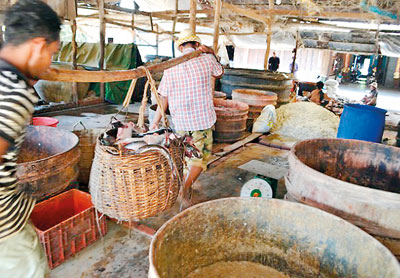Sunday Times 2
The rise and fall of the world’s poorest nations
UNITED NATIONS (IPS) – The world’s 48 Least Developed Countries (LDCs) – a special category of developing nations created by the General Assembly in 1971 but refused recognition by the World Bank – have long been described as “poorest of the poor” in need of special international assistance for their economic survival.
But only three – Botswana, Cape Verde and the Maldives – have so far “graduated” from being classified as an LDC to a developing nation, based primarily on their improved social and economic performance.

Fish being brought in and processed at a market in Cambodia's northwestern Battambang province. As an LDC, Cambodia exports products duty-free to the EU. Credit: Michelle Tolson/IPS
At a U.N.-sponsored ministerial meeting of Asian and Pacific nations in Nepal last month, four more LDCs, namely Bangladesh, Bhutan, Cambodia and Laos, were singled out as countries on the “threshold of graduation” based on their recent economic and social indicators.
And as economies improve, some predict that at least six more countries – Tuvalu, Vanuatu, Kiribati, Samoa, Angola and Equatorial Guinea (two African nations dependent on oil incomes) – are likely to be forced out of the ranks of LDCs, possibly by 2020 or beyond.
But this outlook may be premature due to several factors, including the impact of the global economic recession, the long-term effects of the decline in oil prices, reduced purchasing power due to falling national currencies, and in the case of Africa, the spread of Ebola.
Ambassador Anwarul Karim Chowdhury, the first U.N. Under-Secretary-General and High Representative for LDCs, Landlocked Developing Countries, and Small Island Developing States (2002-2007), told IPS the 2011 LDCs Conference in Istanbul, Turkey, set an objective of graduating 50 per cent of LDCs out of the group by 2020.
“But this mechanical setting of a target for graduation is impractical and has the potential of undesirable tension for development cooperation at national and global levels,” he pointed out.
The foremost objective of graduation should be to bring LDCs out of poverty and their structural handicaps, he noted.
“But given the current distressing situation in most of the LDCs in both areas, it would be unwise for either the LDCs or their development partners to go towards realising this target,” Chowdhury added.
The people of these countries, particularly civil society, should be involved in the process to ensure that common people of LDCs do not become the greatest victims, he said.
“This is a reality in LDCs which we should not lose sight of,” he declared.
According to the United Nations, LDCs represent the poorest and weakest members of the international community, comprising more than 880 million people and accounting for less than 2.0 per cent of global Gross Domestic Product (GDP).
Fighting poverty in the LDCs is a key component towards reaching the U.N.’s landmark 2015 Millennium Development Goals (MDGs).
LDCs currently benefit from a range of special support measures from bilateral donors and multilateral organisations, and special treatment under regional and multilateral trade agreements.
The benefits that will be lost or reduced due to LDC graduation include trade preferences, official development assistance (ODA) including development financing and technical cooperation, and other forms of assistance, such as travel support for participation at U.N. conferences and other meetings of multilateral bodies.
As a result, special attention needs to be given to these special measures for graduating LDCs.
Arjun Karki, president of Rural Reconstruction of Nepal and international coordinator of LDC Watch, a network of LDC non-governmental organisations (NGOs), told IPS the aim of the 2011 Istanbul Programme of Action was to enable at least 24 LDCs (half of the existing 48) to graduate by 2020, so the current proposals for graduation have not reached this level.
The majority of LDCs (34 out of 48) are in Africa and to date only two African nations, Angola and Equatorial Guinea, are expected to graduate by 2020.
In both these cases, graduation is solely based on their income criterion (of Gross National Income per capita having exceeded at least twice the upper threshold of 1,190 dollars) while they fare low in the human assets and economic vulnerability criteria.
He said LDCs can only graduate when both LDC governments and development partners take action and it is vital they both have the political will to achieve this.
Gyan Chandra Acharya, the current Under-Secretary-General and High Representative for LDCs, Landlocked Developing Countries and Small Island Developing States, told delegates at the ministerial meeting in Nepal “the path towards graduation should not be an end in itself but should be viewed as a launching pad towards meaningful and transformative changes in the economic structures and the life conditions of people in graduated and graduating LDCs.”
He said sustainable graduation agenda needs to be tied up with that of productive capacity development, structural transformation resilience building and sustainable improvement in human and social capital.

